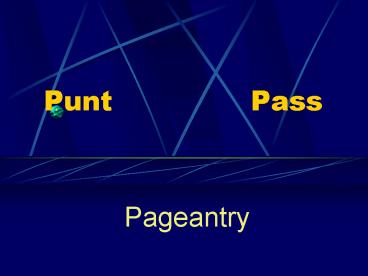Punt Pass - PowerPoint PPT Presentation
1 / 18
Title:
Punt Pass
Description:
NPTR- 154 injuries in 49540 patients-7 years (only 31- grades III,IV,V) ... IV- Proximal transection or parenchymal injury involving ampulla (R of SMV) ... – PowerPoint PPT presentation
Number of Views:33
Avg rating:3.0/5.0
Title: Punt Pass
1
Punt Pass
- Pageantry
2
Incidence of Pediatric Pancreatic Trauma
- NPTR- 154 injuries in 49540 patients-7 years
(only 31- grades III,IV,V) - Canty 18 major ductal injuries-14,245 admissions,
14 years (2.3 million)
3
Mechanisms of Pancreatic Trauma
- Blunt force traps pancreas against vertebral
column - Lap belt related, falls, bicycle wrecks, abuse
- Angle of force dictates location of injury
- Especially true with improperly restrained
children
4
Diagnosis of Pancreatic Trauma
- Spiral CT IV contrast /- GI contrast
- MR Cholangiopancreatography (MRCP)
- Mechanism should alert to pancreatic injury
- Amylasegt200 and Lipasegt1800 exam
- Enzyme levels are not perfectly reliable
5
Anatomic variant
6
AAST Pancreas Injury Scale
- I- Minor contusion without duct injury
- II-Superficial laceration without duct injury,
major contusion without duct injury or tissue
loss - III- Distal transection or parenchymal injury
with duct injury - IV- Proximal transection or parenchymal injury
involving ampulla (R of SMV) - V- Massive disruption of pancreatic head
7
Punt!- Nonoperative
- Nonoperative treatment correct for children
without major duct/gland disruption (grades I and
II) - Minor injury accounts for 80 of pediatric
pancreas injury - Operative drainage is not useful
8
Punt- Define the Injury
- What to do with ductal transection (III)
- Proximal duct vs distal duct
- Can the pancreas be treated like the spleen,
liver, and kidney in children? - Rigid adherence to non-operative management is a
mistake
9
Nonoperative treatment- distal duct
- Toronto- 10 patients with complete transection
in 10 years (population?) - 9 with complete records
- Median Hosp days-24
- 4 pseudocysts drained
- Atrophy distal gland in 6/8
- Possibly an incomplete review
10
Assume you Punt-Management of Pseudocyst
- Many resolve without treatment
- Kouchi, et al- Japan- 20 patients
- lt10 cm, most will resolve
- gt10 cm, most will need drainage
- 1 died- TPN related
- 5 mortality
11
Pass- Operation for Distal Transections
- Delay in diagnosis is common
- Historically, only 50 are diagnosed upon
admission, thus the high incidence of pseudocyst - Spiral CT may improve this number
- Surgical management reasonable, possibly up to 7
days
12
Pass- Surgery for Distal Transections
- Spleen sparing distal pancreatectomy
- Dallas- 5 patients dx in 12 hours,6 patients dx
in 36 hours - 9 had surgery within 72 hours
- Median hospital stay 11 days
- 1 late morbidity
13
Pageantry-Stenting
- Proximal Duct Injury
- Canty- nonoperative tx of proximal duct inj (IV
or V) - ERCP or MRCP if in doubt
- Very few Peds GI people are able to do this!
Think about calling the adult GI folks
14
Pageantry- Laparoscopic repair
- Not recommended for proximal injuries
- Not recommended if other injuries suspected
(i.e.-bowel) - More than 2 hours of pneumoperitoneum will start
to increase complications
15
(No Transcript)
16
(No Transcript)
17
(No Transcript)
18
Summary
- No ductal injury- Observe
- Midbody Transection- spleen sparing distal
pancreatectomy possibly out to 7 days post injury
or observe - Proximal complex injury- observe and treat the
pseudocyst or stent

